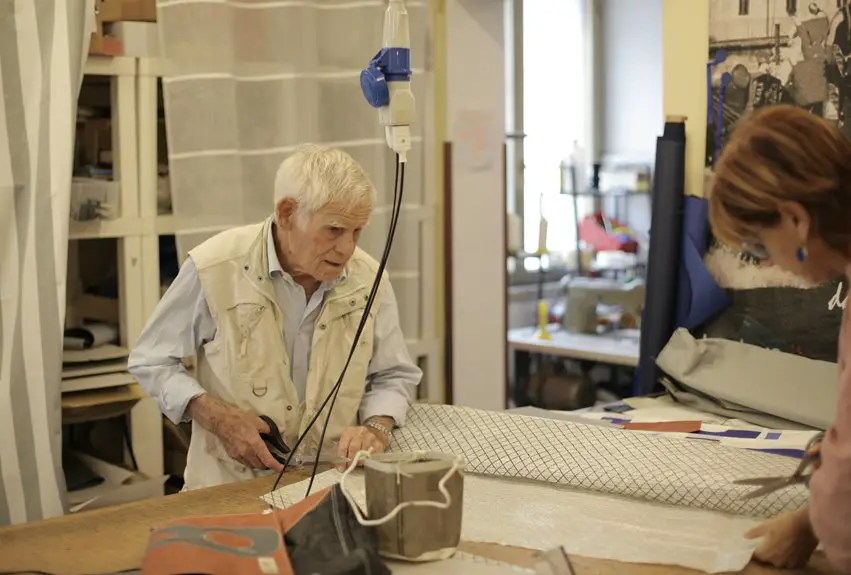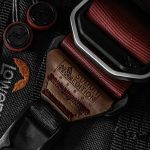When working with 12IN x 5ft Kevlar fabric, you’ll want to measure and mark precisely for durable, protective cuts ideal for safety gear like gloves and sleeves. Use sharp rotary cutters on a stable surface to avoid fraying, then seal edges with low heat to maintain strength. This flexible, heat-resistant material stands up to tough conditions while keeping you safe. If you want to guarantee maximum efficiency and fabric integrity, there are some handy tips you’ll find useful next.
Table of Contents
Key Takeaways
- Cut 12in x 5ft Kevlar into glove reinforcements, sleeves, or protective patches for heat and cut resistance in safety gear.
- Use sharp rotary cutters or specialized scissors on a stable surface for clean, precise Kevlar fabric cuts.
- Seal cut edges immediately with low-temperature heat or fabric adhesive to prevent fraying and maintain durability.
- Design practical dimensions for knee/elbow pads or welding apron components to maximize flexibility and protection.
- Store cut Kevlar flat, dry, and away from moisture to preserve fabric integrity for safety equipment use.
Understanding the Properties of Kevlar Fabric
Kevlar fabric stands out for its exceptional strength and durability, making it ideal for safety equipment.
Kevlar fabric’s unmatched strength and durability make it the perfect choice for reliable safety gear.
When you handle Kevlar, you’ll notice it’s lightweight yet incredibly tough. This synthetic fiber resists cuts, abrasions, and impacts better than many materials, which is why it’s trusted in protective gear.
Its high tensile strength means it can absorb and distribute energy efficiently, reducing injury risk. Additionally, Kevlar resists heat and flames, so you won’t worry about it melting or igniting easily.
You’ll also appreciate its flexibility, allowing for comfortable movement without sacrificing protection.
Understanding these properties helps you choose Kevlar fabric confidently, ensuring your safety gear performs reliably under demanding conditions.
Ideal Safety Equipment Applications for 12IN X 5ft Kevlar
You’ll find 12IN X 5ft Kevlar perfect for making protective gear components that need durability and flexibility.
It’s great for heat-resistant applications where safety is critical, like firefighter gloves or welding sleeves.
Plus, its cut-resistant properties make it ideal for materials used in industrial and construction settings.
Protective Gear Components
When selecting materials for protective gear, you want something that offers strength without sacrificing flexibility. Kevlar fabric, especially in 12IN X 5ft cuts, fits this need perfectly.
You can use it to reinforce gloves, providing cut resistance while maintaining dexterity. It’s ideal for lining sleeves or jackets to shield against abrasions and impacts without bulk.
You’ll find it excellent for knee and elbow pads, where durability and flexibility matter most. Plus, Kevlar inserts in helmets enhance protection without adding excessive weight.
Heat-Resistant Applications
Beyond its strength and flexibility, the fabric’s heat-resistant properties make it a top choice for safety equipment exposed to high temperatures.
When you use 12IN X 5ft Kevlar fabric, you can confidently create gear that shields against intense heat without compromising comfort.
Whether you’re crafting protective sleeves or welding blankets, this fabric stands up to the challenge.
Consider these heat-resistant applications for your Kevlar fabric:
- Welding aprons and gloves: Protect yourself from sparks and molten metal splashes.
- Firefighter hoods and liners: Offer critical heat defense during emergency response.
- Industrial insulation wraps: Safeguard machinery and personnel from heat exposure.
Cut-Resistant Material Uses
Although Kevlar is renowned for its heat resistance, its exceptional cut-resistant qualities make it equally valuable for safety gear.
When you work with sharp tools or in hazardous environments, 12IN X 5ft Kevlar fabric offers reliable protection against cuts and abrasions. You can use it to reinforce gloves, sleeves, or aprons, reducing injury risks during tasks like glass handling, metal fabrication, or woodworking.
Its lightweight nature guarantees you stay agile without compromising safety. Additionally, Kevlar’s durability extends the lifespan of your protective gear, saving you money over time.
Measuring and Marking Kevlar for Accurate Cuts
Precision is key as you measure and mark Kevlar fabric for cutting, ensuring each piece fits its intended safety application perfectly.
Before you start, lay the fabric flat on a clean surface to avoid distortion. Use a reliable measuring tape and mark with a fabric chalk or a fine-tip marker designed not to bleed. Keep your measurements consistent to prevent waste or misfit.
Consider these tips:
- Double-check all measurements before marking to avoid errors.
- Mark on the fabric’s backside if possible, preserving the front’s integrity.
- Use straight edges or rulers to maintain clean, precise lines.
Tools and Techniques for Cutting Kevlar Fabric
When cutting Kevlar fabric, you’ll need sharp tools like rotary cutters or specialized scissors to get clean edges.
You should use safe methods to avoid damaging the material or hurting yourself.
Plus, taking steps to prevent fraying will keep your cuts durable and precise.
Essential Cutting Tools
Cutting Kevlar fabric requires specialized tools designed to handle its tough, tightly woven fibers without fraying or damaging the material. You’ll need sharp, precise instruments to guarantee clean cuts and maintain the fabric’s integrity.
Here are three essential cutting tools you’ll want to take into account:
- Rotary Cutter: Offers smooth, straight cuts and works well on flat surfaces.
- Heavy-Duty Scissors: Designed specifically for strong fabrics, providing control and accuracy.
- Electric Fabric Cutter: Ideal for repetitive or larger cuts, delivering consistent results quickly.
Using the right tool not only makes your job easier but also prevents damage that could compromise the safety equipment you’re crafting.
Choose tools based on the size and complexity of your cuts for the best outcome.
Safe Cutting Methods
Choosing the right tools sets the stage, but how you handle those tools makes all the difference in working with Kevlar fabric safely. You want sharp, precise cuts to avoid damaging the fibers. Use rotary cutters or heavy-duty scissors designed for tough fabrics. Always cut on a stable surface to maintain control. Keep your fingers clear and cut slowly to prevent slips.
| Emotion | Technique |
|---|---|
| Confidence | Use sharp blades |
| Safety | Cut on a flat, stable surface |
| Control | Slow, deliberate cutting |
| Precision | Follow fabric weave lines |
Preventing Fabric Fraying
Although Kevlar fabric is incredibly durable, it tends to fray easily along cut edges if not handled properly. To keep your cuts clean and prevent fraying, you need the right tools and techniques.
Start by using sharp, fine scissors or a rotary cutter designed for tough fabrics. Next, seal the edges immediately after cutting. You can use heat sealing tools, fabric glue, or specialized fray-preventing tapes.
Here are key tips to avoid fraying:
- Use sharp cutting tools to guarantee clean edges
- Apply heat or fray sealant right after cutting
- Consider double-stitching edges for extra durability
Maximizing Fabric Usage and Minimizing Waste
When you optimize the layout of Kevlar fabric patterns, you’ll reduce waste and save costs considerably. Start by planning your cuts carefully, fitting smaller pieces into gaps left by larger ones. Use templates to avoid mistakes, and always measure twice before cutting. This approach guarantees every inch of your 12in x 5ft fabric serves a purpose.
| Cut Piece Size | Quantity Needed | Remaining Fabric (inches) |
|---|---|---|
| 4in x 5ft | 2 | 4in x 5ft |
| 3in x 5ft | 1 | 1in x 5ft |
| 2in x 5ft | 1 | 0in x 5ft |
| Scrap | Minimal | Use for patches |
Tips for Maintaining Kevlar Fabric Integrity After Cutting
To keep your Kevlar fabric strong and reliable after cutting, handle the edges with care to prevent fraying and damage.
After making your cuts, you’ll want to seal the edges properly to maintain the fabric’s integrity. Avoid pulling or stretching the fabric near the cut areas, as this can weaken the fibers. Use appropriate tools and techniques to protect your investment in safety gear.
Here are some key tips to maintain Kevlar fabric after cutting:
- Apply heat sealing with a low-temperature iron or specialized tool to prevent unraveling.
- Use fabric adhesive or edge binding tape to reinforce cut edges.
- Store cut pieces flat and avoid folding to prevent creases and fiber distortion.
Following these steps guarantees your Kevlar fabric stays durable and effective for safety applications.
Frequently Asked Questions
Can Kevlar Fabric Be Dyed or Colored After Cutting?
Think of Kevlar like a stubborn chameleon—it doesn’t easily change colors. You can’t dye it after cutting because its fibers resist most dyes, so you’ll need to choose your color before you work with it.
What Is the Shelf Life of Unused Kevlar Fabric?
You can expect unused Kevlar fabric to last around 5 to 10 years if stored properly—away from sunlight, moisture, and extreme temperatures. Just keep it sealed and cool to maintain its strength and durability over time.
Are There Environmental Concerns With Disposing of Kevlar Scraps?
Disposing of Kevlar scraps isn’t like tossing biodegradable waste; you can’t just throw them away carelessly. You’ll want to follow local regulations since Kevlar doesn’t break down easily and could impact the environment if not handled properly.
Can Kevlar Fabric Be Machine Washed Safely?
You can machine wash Kevlar fabric, but use cold water and a gentle cycle to keep it safe. Avoid bleach and fabric softeners since they can damage the fibers and reduce Kevlar’s protective properties over time.
Is Kevlar Fabric Recyclable or Reusable in Other Products?
Like a phoenix rising, you can give Kevlar new life. While recycling options are limited, you can reuse it creatively in gear, patches, or crafts, turning its strength into something fresh and practical again.
- Tetron Fabric for Marine Applications: Durability and Use Cases - June 18, 2025
- Tetron Fabric for Outdoor Furniture: Weather Resistance and Care - June 18, 2025
- Tetron Fabric for Wall Coverings: Style and Application Tips - June 18, 2025







